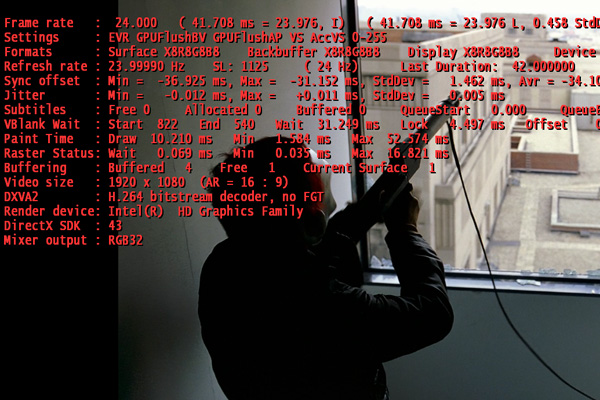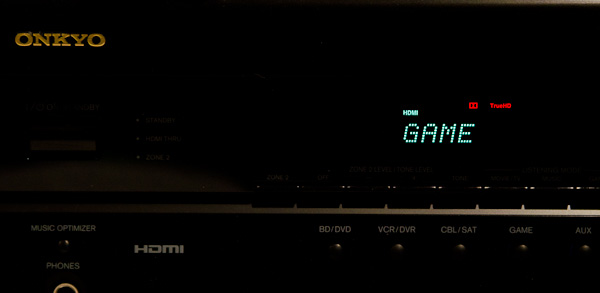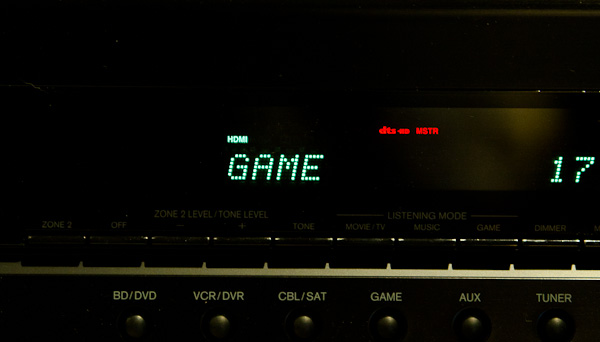The Sandy Bridge Review: Intel Core i7-2600K, i5-2500K and Core i3-2100 Tested
by Anand Lal Shimpi on January 3, 2011 12:01 AM ESTA Near-Perfect HTPC
Since 2006 Intel’s graphics cores have supported sending 8-channel LPCM audio over HDMI. In 2010 Intel enabled bitstreaming of up to eight channels of lossless audio typically found on Blu-ray discs via Dolby TrueHD and DTS-HD MA codecs. Intel’s HD Graphics 3000/2000 don’t add anything new in the way of audio or video codec support.
Dolby Digital, TrueHD (up to 7.1), DTS, DTS-HD MA (up to 7.1) can all be bitstreamed over HDMI. Decoded audio can also be sent over HDMI. From a video standpoint, H.264, VC-1 and MPEG-2 are all hardware accelerated. The new GPU enables HDMI 1.4 and Blu-ray 3D support. Let’s run down the list:
Dolby TrueHD Bitstreaming? Works:
DTS HD-MA bitstreaming? Yep:
Blu-ray 3D? Make that three:
How about 23.976 fps playback? Sorry guys, even raking in $11 billion a quarter doesn’t make you perfect.
Here’s the sitch, most movie content is stored at 23.976 fps but incorrectly referred to as 24p or 24 fps. That sub-30 fps frame rate is what makes movies look like, well, movies and not soap operas (this is also why interpolated 120Hz modes on TVs make movies look cheesey since they smooth out the 24 fps film effect). A smaller portion of content is actually mastered at 24.000 fps and is also referred to as 24p.
In order to smoothly playback either of these formats you need a player and a display device capable of supporting the frame rate. Many high-end TVs and projectors support this just fine, however on the playback side Intel only supports the less popular of the two: 24.000Hz.
This isn’t intentional, but rather a propagation of an oversight that started back with Clarkdale. Despite having great power consumption and feature characteristics, Clarkdale had one glaring issue that home theater enthusiasts discovered: despite having a 23Hz setting in the driver, Intel’s GPU would never output anything other than 24Hz to a display.
The limitation is entirely in hardware, particularly in what’s supported by the 5-series PCH (remember that display output is routed from the processor’s GPU to the video outputs via the PCH). One side effect of trying to maintain Intel’s aggressive tick-tock release cadence is there’s a lot of design reuse. While Sandy Bridge was a significant architectural redesign, the risk was mitigated by reusing much of the 5-series PCH design. As a result, the hardware limitation that prevented a 23.976Hz refresh rate made its way into the 6-series PCH before Intel discovered the root cause.
Intel had enough time to go in and fix the problem in the 6-series chipsets, however doing so would put the chipset schedule at risk given that fixing the problem requires a non-trivial amount of work to correct. Not wanting to introduce more risk into an already risky project (brand new out of order architecture, first on-die GPU, new GPU architecture, first integrated PLL), Intel chose to not address it this round, which is why we still have the problem today.

Note the frame rate
What happens when you try to play 23.976 fps content on a display that refreshes itself 24.000 times per second? You get a repeated frame approximately every 40 seconds to synchronize the source frame rate with the display frame rate. That repeated frame appears to your eyes as judder in motion, particularly evident in scenes involving a panning camera.
How big of an issue this is depends on the user. Some can just ignore the judder, others will attempt to smooth it out by setting their display to 60Hz, while others will be driven absolutely insane by it.
If you fall into the latter category, your only option for resolution is to buy a discrete graphics card. Currently AMD’s Radeon HD 5000 and 6000 series GPUs correctly output a 23.976Hz refresh rate if requested. These GPUs also support bitstreaming Dolby TrueHD and DTS-HD MA, while the 6000 series supports HDMI 1.4a and stereoscopic 3D. The same is true for NVIDIA’s GeForce GT 430, which happens to be a pretty decent discrete HTPC card.
Intel has committed to addressing the problem in the next major platform revision, which unfortunately seems to be Ivy Bridge in 2012. There is a short-term solution for HTPC users absolutely set on Sandy Bridge. Intel has a software workaround that enables 23.97Hz output. There’s still a frame rate mismatch at 23.97Hz, but it would be significantly reduced compared to the current 24.000Hz-only situation.
MPC-HC Compatibility Problems
Just a heads up. Media Player Classic Home Cinema doesn't currently play well with Sandy Bridge. Enabling DXVA acceleration in MPC-HC will cause stuttering and image quality issues during playback. It's an issue with MPC-HC and not properly detecting SNB as far as I know. Intel has reached out to the developer for a fix.














283 Comments
View All Comments
Rick83 - Monday, January 3, 2011 - link
I just checked the manual to MSI's 7676 Mainboard (high-end H67) and it lists cpu core multiplier in the bios (page 3-7 of the manual, only limitation mentioned is that of CPU support), with nothing grayed out and overclockability a feature. As this is the 1.1 Version, I think someone misunderstood something....Unless MSI has messed up its Manual after all and just reused the P67 Manual.... Still, the focus on over-clocking would be most ridiculous.
Rick83 - Monday, January 3, 2011 - link
also, there is this:http://www.eteknix.com/previews/foxconn-h67a-s-h67...Where the unlocked multiplier is specifically mentioned as a feature of the H67 board.
So I think anandtech got it wrong here....
RagingDragon - Monday, January 3, 2011 - link
Or perhaps CPU overclocking on H67 is not *officially* supported by Intel, but the motherboard makers are supporting it anyway?IanWorthington - Monday, January 3, 2011 - link
Seems to sum it up. If you want both you have to wait until Q2.<face palm>
8steve8 - Monday, January 3, 2011 - link
so if im someone who wants the best igp, but doesn't want to pay for overclockability, i still have to buy the K cpu... weird.beginner99 - Monday, January 3, 2011 - link
yep. This is IMHO extremely stupid. Wanted to build a PC for someone that mainly needs CPU power (video editing). An overclocked 2600k would be ideal with QS but either wait another 3 month or go all compromise...in that case H67 probably but still paying for K part and not being able to use it.Intel does know how to get the most money from you...
Hrel - Monday, January 3, 2011 - link
haha, yeah that is stupid. You'd think on the CPU's you can overclock "K" they use the lower end GPU or not even use one at all. Makes for an awkward HTPC choice.AkumaX - Monday, January 3, 2011 - link
omg omg omg wat do i do w/ my i7-875k... (p.s. how is this comment spam?)AssBall - Monday, January 3, 2011 - link
Maybe because you sound like a 12 year old girl with ADHD.usernamehere - Monday, January 3, 2011 - link
I'm surprised nobody cares there's no native USB 3.0 support coming from Intel until 2012. It's obvious they are abusing their position as the number 1 chip maker, trying to push Light Peak as a replacement to USB. The truth is, Light Peak needs USB for power, it can never live without it (unless you like to carry around a bunch of AC adapters).Intel wants light peak to succeed so badly, they are leaving USB 3.0 (it's competitor) by the wayside. Since Intel sits on the USB board, they have a lot of pull in the industry, and as long as Intel wont support the standard, no manufacturer will ever get behind it 100%. Sounds very anti-competitive to me.
Considering AMD is coming out with USB 3.0 support in Llano later this year, I've already decided to jump ship and boycott Intel. Not because I'm upset with their lack of support for USB 3.0, but because their anti-competitive practices are inexcusable; holding back the market and innovation so their own proprietary format can get a headstart. I'm done with Intel.